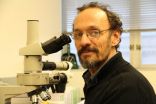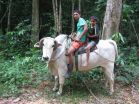(Press-News.org) PORTLAND, Ore. -- A large international group of scientists, including an Oregon Health & Science University neuroscientist, is publishing this week the results of a first-ever look at the genome of dozens of common birds. The scientists' research tells the story of how modern birds evolved after the mass extinction that wiped out dinosaurs and almost everything else on Earth 66 million years ago, and gives new details on how birds came to have feathers, flight and song.
The consortium of more than 200 scientists is publishing its findings nearly simultaneously this week in 23 papers -- eight papers in a Dec. 12 special issue of Science and 15 more in Genome Biology, BMC Genomics and other journals.
Taken as a whole, the papers give science important new insights into the family tree of birds, including the molecular details of the burst of evolution in birds that quickly followed the mass extinction of three-quarters of Earth's plants and animals. Non-avian dinosaurs didn't survive that extinction but avian dinosaurs, what came to be today's birds, did. Birds fairly quickly -- on an evolutionary scale, over several million years -- developed into more than 10,000 species.
"This project generated an unprecedented amount of genomic data for a single group of vertebrates," said Claudio Mello, Ph.D., professor of behavioral neuroscience in the OHSU School of Medicine and co-author or senior author on several of the consortium's papers. "The high diversity of birds is fascinating to us all, and definitely influenced Darwin when he used finches on the Galapagos Islands to help formulate his theory of evolution. But that diversity has also presented challenges in understanding birds' family tree. The new data helped build a more accurate tree of life of birds, but also led to a much deeper understanding of how changes in the genome of a dinosaur ancestor gave rise to many typical bird traits."
As part of the project, the consortium sequenced and compared the full genomes of 48 bird species, including the crow, duck, falcon, parakeet, crane, woodpecker, eagle and dozens of others. The genomes sequenced represented all major branches of modern birds. A hummingbird species prevalent in the Pacific Northwest was among the bird species analyzed. The species, called Anna's hummingbird, was provided by Mello's lab.
The work involved scientists working in a half dozen countries with nine supercomputers and the equivalent of 400 years of computer processing time.
Among other things, the consortium's work helps scientists understand connections between different species of birds -- connections they didn't know existed before. The work also reveals how vocal "learning" of songs evolved in songbirds, and shows that many of the genes involved in that learning are similar to genes involved in human speech.
"Our data helped solidify the surprising notion that parrots and songbirds are sister groups in the tree of life of birds, so their shared ability to learn songs -- in the case of parrots, human speech sounds -- likely had a common origin," Mello said. "In contrast, hummingbirds are separate, so their ability to learn songs -- yes, hummingbirds sing and learn how to sing from their parents -- arose separately in evolution."
Mello is an international expert on the science of songbirds' learning their vocalizations. He was co-author of three of the Science articles and the senior author on two other papers. The Mello lab also has been involved in cataloging the brain expression of a large collection of genes in songbirds, an online atlas that played a fundamental role in the comparative studies of the consortium.
A Science paper co-authored by Mello focused on genes in songbird brains associated with learning songs. Many of these genes are the same as genes in the human brain associated with language and speech. Another paper on which Mello was senior author looked at genes unique to songbirds that arose as birds evolved to improve vocal learning.
"In both cases, we believe that finding these genes takes us one step closer to understanding the biological and genetic basis of vocal learning -- which in humans is the basis for speech and language learning," Mello said. "This may help us to better understand how speech and language work, and also identify some possible genetic causes of speech and language impairments, a novel and exciting area of research that sounded very esoteric not too long ago. The studies in birds will help us understand where and how these genes work in the brain, and thus devise better approaches to combat speech problems in humans."
The consortium was led by Guojie Zhang of the National Genebank at BGI in China and the University of Copenhagen, M. Thomas P. Gilbert of the Natural History Museum of Denmark, and Erich D. Jarvis of Duke University and the Howard Hughes Medical Institute. Jarvis and Mello have collaborated closely over several years and have co-authored studies that fully mapped vocal control centers in the brains of parrots and hummingbirds.
INFORMATION:
The project received its main financial support from National Genebank in China, from the U.S. National Institutes of Health, the U.S. National Science Foundation, the Howard Hughes Medical Institute, the Lundbeck Foundation and the Danish National Research Foundation. The Mello lab was supported by a grant from the NIH (grant # R24-GM092842) and from the Brazilian Ministry of Science and Technology -- the latter to sequence the genome of some tropical birds.
About the OHSU Brain Institute
The Oregon Health & Science University Brain Institute is a national neuroscience leader in patient care, research and education. With more than 1,000 brain scientists and specialists, OHSU is home to one of the largest communities of brain and central nervous system experts in the nation. OHSU Brain Institute scientists have won national recognition for breaking new ground in understanding Alzheimer's disease and for discoveries that have led to new treatments for Parkinson's disease, multiple sclerosis, stroke and other brain disorders and diseases.
About OHSU
Oregon Health & Science University is the state's only public academic health and research university. As one of Oregon's largest employers with more than 14,000 employees, OHSU's size contributes to its ability to provide many services and community support not found anywhere else in the state. OHSU serves patients from every corner of Oregon and is a conduit for learning for more than 4,400 students and trainees. OHSU is the source of more than 200 community outreach programs that bring health and education services to each county in the state.
A team of researchers led by North Carolina State University has found that stacking materials that are only one atom thick can create semiconductor junctions that transfer charge efficiently, regardless of whether the crystalline structure of the materials is mismatched - lowering the manufacturing cost for a wide variety of semiconductor devices such as solar cells, lasers and LEDs.
"This work demonstrates that by stacking multiple two-dimensional (2-D) materials in random ways we can create semiconductor junctions that are as functional as those with perfect alignment" ...
Agricultural decisions made by our ancestors more than 10,000 years ago could hold the key to food security in the future, according to new research by the University of Sheffield.
Scientists, looking at why the first arable farmers chose to domesticate some cereal crops and not others, studied those that originated in the Fertile Crescent, an arc of land in western Asia from the Mediterranean Sea to the Persian Gulf.
They grew wild versions of what are now staple foods like wheat and barley along with other grasses from the region to identify the traits that make some ...
GAINESVILLE, Fla. --- Nature abhors a vacuum, which may explain the findings of a new study showing that bird evolution exploded 65 million years ago when nearly everything else on earth -- dinosaurs included -- died out.
The study is part of an ambitious project, published in today's issue of the journal Science, in which hundreds of scientists worldwide have decoded the avian genome.
Edward Braun, an evolutionary geneticist at the University of Florida and the UF Genetics Institute, is one of the key scientists who took part in this multi-year project that used nine ...
(Santa Barbara, Calif.) -- With more and more rainforest giving way to pasture and grazing land every year, the practice of cattle ranching in the Amazon has serious implications on a global scale. At the same time, however, it provides a degree of socioeconomic flexibility for Amazonian smallholders who simply can't survive on what the forest or agriculture provide.
In a paper published in the current issue of the journal Human Organization, UC Santa Barbara anthropologist Jeffrey Hoelle takes a look at the rise of cattle ranching in the Brazilian state of Acre and the ...
Astronomers using the Atacama Large Millimeter/submillimeter Array (ALMA) may have detected the dusty hallmarks of an entire family of Pluto-size objects swarming around an adolescent version of our own Sun.
By making detailed observations of the protoplanetary disk surrounding the star known as HD 107146, the astronomers detected an unexpected increase in the concentration of millimeter-size dust grains in the disk's outer reaches. This surprising increase, which begins remarkably far -- about 13 billion kilometers -- from the host star, may be the result of Pluto-size ...
COLUMBUS, Ohio - If dieting is on your New Year agenda, it might pay to be mindful of a study suggesting there is little hard evidence that mindfulness leads to weight loss.
Ohio State University researchers reviewed 19 previous studies on the effectiveness of mindfulness-based programs for weight loss. Thirteen of the studies documented weight loss among participants who practiced mindfulness, but all lacked either a measure of the change in mindfulness or a statistical analysis of the relationship between being mindful and dropping pounds. In many cases, the studies ...
BOSTON (December 11, 2014) -- A new study from epidemiologists at Tufts University School of Medicine helps to identify communities with the greatest public health need in Massachusetts for resources relating to HIV/AIDS and hepatitis C. The study, published today in PLOS ONE, used geospatial techniques to identify hotspots for deaths related to HIV/AIDS and hepatitis C. The findings show large disparities in death rates exist across race and ethnicity in Massachusetts.
The HIV/AIDS and hepatitis C epidemics are challenging public health officials and clinicians in the ...
BALTIMORE, December 11, 2014 - Insilico Medicine along with scientists from Vision Genomics and Howard University shed light on AMD disease, introducing the opportunity for eventual diagnostic and treatment options.
The scientific collaboration between Vision Genomics, Inc., Howard University, and Insilico Medicine, Inc., has revealed encouraging insight on the AMD disease using an interactome analysis approach. Resources such as publicly available gene expression data, Insilico Medicine's original algorithm OncoFinderTM, and AMD MedicineTM from Vision Genomics allowed ...
How much protection the annual flu shot provides depends on how well the vaccine (which is designed based on a "best guess" for next season's flu strain) matches the actually circulating virus. However, it also depends on the strength of the immune response elicited by the vaccine. A study published on December 11th in PLOS Pathogens reports that genetic variants in a gene called IL-28B influence influenza vaccine responses.
Adrian Egli, from the University of Basel, Switzerland, and colleagues started with blood samples from organ transplant patients. Such patients are ...
New circulating metabolites might allow early diagnosis of cardiovascular disease. A team of scientists from Uppsala University, Karolinska Institutet and Colorado State University have identified novel lipid-derived molecules associated with future coronary heart disease events. The study published in the journal PLOS Genetics has examined the metabolic profile of blood samples from more than 3,600 individuals that have been followed-up for up to 10 years.
Professor Erik Ingelsson and graduate student Andrea Ganna have used novel biochemical and bioinformatics approaches ...



